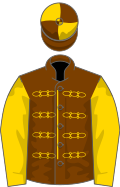 | |
| Class | Group 1 |
|---|---|
| Location | Ascot Racecourse Ascot, England (since 2011) |
| Inaugurated | 1877 |
| Race type | Flat / Thoroughbred |
| Sponsor | QIPCO |
| Website | Ascot |
| Race information | |
| Distance | 1m 1f 212y (2,004 metres) |
| Surface | Turf |
| Track | Right-handed |
| Qualification | Three-years-old and up |
| Weight | 9 st 3 lb (3yo); 9 st 7 lb (4yo+) Allowances 3 lb for fillies and mares |
| Purse | £1,417,500 (2025) 1st: £803,864 |
| 2025 | ||
 |  |  |
| Calandagan | Ombudsman | Almaqam |
| Previous years | ||
|---|---|---|
| 2024 | ||
 |  |  |
| Anmaat | Calandagan | Royal Rhyme |
| 2023 | ||
 |  |  |
| King Of Steel | Via Sistina | Horizon Dore |
| 2022 | ||
 |  |  |
| Bay Bridge | Adayar | My Prospero |
| 2021 | ||
 |  |  |
| Sealiway | Dubai Honour | Mac Swiney |
| 1970–1969 | ||
|---|---|---|
| 1970 | ||
 |  |  |
| Lorenzaccio | Nijinsky | Hotfoot |
| 1969 | ||
 |  |  |
| Flossy | Park Top | Lorenzaccio |
The Champion Stakes is a Group 1 flat horse race in Great Britain open to thoroughbreds aged three years or older. It is run at Ascot over a distance of 1 mile 1 furlong and 212 yards (2,004 metres), and it is scheduled to take place as part of British Champions Day each year in October.




















































































